Some further articles / resources / graphs:
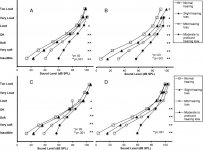
———
A Review of Hyperacusis and Future Directions: Part I. Definitions and Manifestations | American Journal of Audiology | ASHA Publications
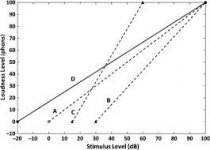
———-
Recruitment of Neurons and Loudness
——-
Translational Perspectives in Auditory Neuroscience: Normal Aspects of Hearing - Kelly L. Tremblay, Robert F. Burkhard - Google Books
——-
Tinnitus-related hyperactivity through homeostatic plasticity in the auditory pathway | BMC Neuroscience | Full Text
“Hearing loss through acoustic trauma or administration of ototoxic drugs leads to the development of increased spontaneous firing rates (hyperactivity) in neurons of the auditory pathway. Hyperactivity in the first processing stage, the dorsal cochlear nucleus (DCN), is correlated to behavioral signs of tinnitus, and the distribution of hyperactivity along the tonotopic axis of the DCN corresponds to the patterns of cochlear damage. Recently, we have proposed that the development of hyperactivity after hearing loss is a consequence of activity stabilization through homeostatic plasticity”
——-
https://asa.scitation.org/doi/abs/10.1121/1.407851
“This suggests that even mildly hearing‐impaired subjects may have difficulty processing complex, time‐varying stimuli. “

———
A Review of Hyperacusis and Future Directions: Part I. Definitions and Manifestations | American Journal of Audiology | ASHA Publications

———-
Recruitment of Neurons and Loudness
——-
Translational Perspectives in Auditory Neuroscience: Normal Aspects of Hearing - Kelly L. Tremblay, Robert F. Burkhard - Google Books
——-
Tinnitus-related hyperactivity through homeostatic plasticity in the auditory pathway | BMC Neuroscience | Full Text
“Hearing loss through acoustic trauma or administration of ototoxic drugs leads to the development of increased spontaneous firing rates (hyperactivity) in neurons of the auditory pathway. Hyperactivity in the first processing stage, the dorsal cochlear nucleus (DCN), is correlated to behavioral signs of tinnitus, and the distribution of hyperactivity along the tonotopic axis of the DCN corresponds to the patterns of cochlear damage. Recently, we have proposed that the development of hyperactivity after hearing loss is a consequence of activity stabilization through homeostatic plasticity”
——-
https://asa.scitation.org/doi/abs/10.1121/1.407851
“This suggests that even mildly hearing‐impaired subjects may have difficulty processing complex, time‐varying stimuli. “
Without trying it myself, it looks to support what I’m driving at.
https://mobile.twitter.com/MBoffin/...774/yanny-laurel-explained&tfw_site=voxdotcom
https://mobile.twitter.com/MBoffin/...774/yanny-laurel-explained&tfw_site=voxdotcom
Scottjoplin,
If you have tinnitus, take a look at some of those docs.
Honestly, I don’t see how it’s possible my hearing isn’t wrecked from years of loud concerts, running with headphones cranked up, etc.
It would make sense to me that those into diyaudio have on average more likelihood of hearing damage than the general population. Maybe, in some subtle or subconscious way, it’s a way to mitigate their own hearing eccentricities and sensitivities.
Kind of like how crazy people tend to become psychologists ;-)
This appears to be a gaping hole in the conversation... the elephant in the room so to speak.
It could explain a lot of the mystery, confusion and disagreement surrounding these sorts of topics. Also, it would make me personally a lot happier knowing that those who claim hearing all of these extremely small or nuanced, in some cases unmeasurable or well below hearing threshold differences aren’t all delusional. A sense of renewed faith in the world
I think Borbely said something to the effect of (I’m probably going to botch this) ‘listen to what they are saying, just don’t assume their explanation or reasons are correct” in reference to the preferences of some for tube amplifiers (I believe).
If you have tinnitus, take a look at some of those docs.
Honestly, I don’t see how it’s possible my hearing isn’t wrecked from years of loud concerts, running with headphones cranked up, etc.
It would make sense to me that those into diyaudio have on average more likelihood of hearing damage than the general population. Maybe, in some subtle or subconscious way, it’s a way to mitigate their own hearing eccentricities and sensitivities.
Kind of like how crazy people tend to become psychologists ;-)
This appears to be a gaping hole in the conversation... the elephant in the room so to speak.
It could explain a lot of the mystery, confusion and disagreement surrounding these sorts of topics. Also, it would make me personally a lot happier knowing that those who claim hearing all of these extremely small or nuanced, in some cases unmeasurable or well below hearing threshold differences aren’t all delusional. A sense of renewed faith in the world
I think Borbely said something to the effect of (I’m probably going to botch this) ‘listen to what they are saying, just don’t assume their explanation or reasons are correct” in reference to the preferences of some for tube amplifiers (I believe).
Last edited:
Mechanism please. That's all I am asking. Not suspicion, mechanism. Or its another case of belief over-riding everything else.
Guess we should add it to the list of research people want to have done but don't want to do themselves.
Space, I'm 53, I've had tinnitus for about 6 years, it came on quite suddenly for no apparent reason, the hearing loss I have is a dip associated with noise damage. The tinnitus is probably connected to the hearing loss. It could be that your hearing has already been damaged, the symptoms are yet to manifest themselves
@spaceistheplace, One question please. Briefly, what is the overall or overreaching reason people here should be interested in the subject matter you seem to be interested in? If someone has abnormal hearing that is not medically fixable, then so what?
Hearing loss is NOT abnormal. Just like dying isn’t abnormal. It also is not an event, but a process.
I believe all here are in the process of “losing their hearing”, at varying speeds and manifestations. Unless there are some young people reading too horrified of how we behave with one another to chime in ;-)
And if you read the papers you’ll see that by loss or deterioration, it does not simply mean “less sound” but more complex perceptual changes.
Look at the average age of those who are claiming hearing varying nuances, then look at the aberrations in the graphs for even those with slight hearing loss. Then compare the magnitude of differences.
Also, most if not all who have had their hearing tested don’t go through a battery like in the papers. I believe most here aren’t aware of the level of hearing changes they have undergone, even if they’ve been tested for high frequency loss.
If you read the information provided I think you will make the connections.
How could this possibly not be relevant?
We need a trove of young women, which I am guessing is in short supply here unless it’s your children.
Last edited:
Pano posted something cool a year ago:
Spectrum of Musical Genres
I thought you might find this interesting. It's the spectral content of music visualized. You can see the tonal balance of different types of music.
The graphs below are FFT analysis of different music genres. The files analyzed for the this test are the average of approximately 112 different recordings in each genre. I averaged those recordings and plotted the spectrum.
Note that the graphs do NOT show how loud the tracks were mastered, because all tracks were normalized before averaging them. That allows for the overlay on one of the plots. The plots just show tonal balance. You can see the relative levels of Bass, Midrange and Treble for each style of music.
Rock section is almost all Classic Rock. Zepplin, Foghat, AC-DC, Janis Joplin, Eagles, Billy Idol, etc.
Jazz tracks are mostly mid-century Bebop or Straight ahead. Dizzy, Miles, Coltrane, Mingus, Art Blakey, Horace Silver, Dave Brubeck, etc.
Classical section is all orchestral, not chamber or choral music.
Opera is a wide selection of mostly 19th century works.
Hip-Hop is whatever I had. Eminem, Dr Dre, and others.
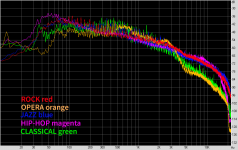
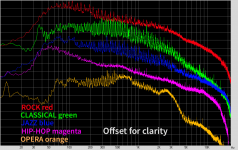
Spectrum of Musical Genres
Thought it might be pertinent.
Plus
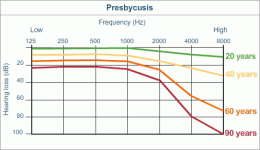
"Normal" and "accelerated" presbycusis
Presbycusis
| Cochlea
PS
I recall that ultrasonic sensing had to do with bone conduction.
THD+N 0.003% at full power is cool but what's it look like at 1W, is it rising, H2 vs H3+, ...
A single study doesn't mean much but rather the bulk of the evidence over time. Has it been repeated? (hence the need for test specs); if it's so groundbreaking, where is the interest?; if it's 20 years old and has no follow up, why?
Spectrum of Musical Genres
I thought you might find this interesting. It's the spectral content of music visualized. You can see the tonal balance of different types of music.
The graphs below are FFT analysis of different music genres. The files analyzed for the this test are the average of approximately 112 different recordings in each genre. I averaged those recordings and plotted the spectrum.
Note that the graphs do NOT show how loud the tracks were mastered, because all tracks were normalized before averaging them. That allows for the overlay on one of the plots. The plots just show tonal balance. You can see the relative levels of Bass, Midrange and Treble for each style of music.
Rock section is almost all Classic Rock. Zepplin, Foghat, AC-DC, Janis Joplin, Eagles, Billy Idol, etc.
Jazz tracks are mostly mid-century Bebop or Straight ahead. Dizzy, Miles, Coltrane, Mingus, Art Blakey, Horace Silver, Dave Brubeck, etc.
Classical section is all orchestral, not chamber or choral music.
Opera is a wide selection of mostly 19th century works.
Hip-Hop is whatever I had. Eminem, Dr Dre, and others.


Spectrum of Musical Genres
Thought it might be pertinent.
Plus

"Normal" and "accelerated" presbycusis
Presbycusis
| Cochlea
PS
I recall that ultrasonic sensing had to do with bone conduction.
THD+N 0.003% at full power is cool but what's it look like at 1W, is it rising, H2 vs H3+, ...
A single study doesn't mean much but rather the bulk of the evidence over time. Has it been repeated? (hence the need for test specs); if it's so groundbreaking, where is the interest?; if it's 20 years old and has no follow up, why?
Last edited:
Hearing loss is NOT abnormal. Just like dying isn’t abnormal. It also is not an event, but a process.
Of course.
How could this possibly not be relevant?
Because it doesn't change anything. We know that some old hearing tests are not fully accurate for 100% of the population. We know that some people claim to hear wooden cable lifter blocks, which we don't believe have any audible effect. We know we need some better way to settle questions of what is really audible to whom. We already know all that. Rehashing all the details won't change anything.
Guess we should add it to the list of research people want to have done but don't want to do themselves.
Has been done where speakers were the culprit not the electronics. This .ppt is an interesting read http://www.davidgriesinger.com/intermod.ppt jn won't like some of it.
THE essential paper on this subject is: Kiryu and Ashihara “Detection of Threshold for tones above 22kHz.” – Convention paper 5401 presented at the 110th Convention, May 12-15 2001, Amsterdam.
The authors presented 13 subjects with a test signal consisting of a 2kHz tone combined with odd order harmonics, both sonic and ultrasonic.
The ultrasonic harmonics were switched on and off at a 2Hz rate.
ALL subjects could discriminate the ultrasonics when the combined signal was presented through a single loudspeaker.
NONE of the subjects could discriminate the ultrasonics when each ultrasonic harmonic was reproduced from a separate speaker.
Last edited:
Okay, thanks. Good info on the ultrasonics.
Cymbals and low level detail cleaned up a lot on my system when the 20+yr old Bryston 4B was replaced with AHB2. No surprise there, shouldn't be anyway. Knew it was time because the Chinese DAC and HPA mod project got the point it started sounding better than my reference system. AHB2 fixed that problem though.
Cymbals and low level detail cleaned up a lot on my system when the 20+yr old Bryston 4B was replaced with AHB2. No surprise there, shouldn't be anyway. Knew it was time because the Chinese DAC and HPA mod project got the point it started sounding better than my reference system. AHB2 fixed that problem though.
Eh? Are we a bunch of grumpy old men behaving badly? Are the young so oversensitiveI believe all here are in the process of “losing their hearing”, at varying speeds and manifestations. Unless there are some young people reading too horrified of how we behave with one another to chime in ;-)
that a little disagreement upsets them? I find some of your comments ageist

I linked to hyperacusis and recruitment not long ago, but I think it fell on “deaf ears” ;-)
I have had hyper for 3 year some time ago ,now I'm ok ...during that time I cannot hear digital music only analog vinyl.....at discrete volume not a problem .
my diy gain a lot by bionic hearing
Has been done where speakers were the culprit not the electronics. This .ppt is an interesting read http://www.davidgriesinger.com/intermod.ppt jn won't like some of it.
I have read dave. He is very good.
Rewind<<<I would expect that the higher the bw of the amp, the better control over ITD, which is significant to imaging.
Jn
Saturating inductors in the PE line is a long established state of the art as it seems : IET Forums - Putting an Inductor in the Safety Earth path
Ah. Ivor Catt....
Guess we should add it to the list of research people want to have done but don't want to do themselves.
I wasn't asking for research to be done, just for someone to come up with a credible hypothesis as to why falling loop gain with frequency is bad once you are below a certain distortion threshold. The Griesinger paper (thanks Scott) suggests that 0.1% distortion is the threshold, but doesn't go into details as to whether that is THD or spot frequency. But it's a stake in the ground. And even the humble LM3886 is 10x better than that number. The 14k border patrol amplifer might struggle though
Rewind<<<This is interesting "interaural time differences"?
One of my biggest concerns is how to guarantee channel to channel timing integrity at the 2 to 5 usec level for frequencies we localize with while the signal is loaded with other content.
For example, when each channel has different content at high level, how accurate will the amp be w/r to phase shift (temporal shift) as the output traverses all four quadrants.
A simple test.. Run a vocal through both channels, defined as being 25 degrees physically to the right of the centered lead guitar (meaning proper IID as well as ITD). Now add bass to the left of center, keyboards right of center, drums centered. Using appropriate measurement electronics, determine it the system is keeping the localization of the vocal accurate to the other instruments..
Hint, that equipment does not exist electronically.
Heck, I'd just be happy to see someone look at timing with simple sines as an amp excercises through four quadrants driving a three way system.
I simply cringe when this is tried using simple resistive loads, that's so....two quadrant..
Remember, the human ear/brain fights inter aural intensity differences if they conflict with interaurel timing differences. Timing wins out, or the listener simply loses the ability to localize.
Jn
Scott w..I will always remember the time I found on Dave's website, him writing up about things he previously wrote that were incorrect. Guts, conviction, desire for truth...class act.
Last edited:
I wasn't asking for research to be done, just for someone to come up with a credible hypothesis as to why falling loop gain with frequency is bad once you are below a certain distortion threshold. The Griesinger paper (thanks Scott) suggests that 0.1% distortion is the threshold, but doesn't go into details as to whether that is THD or spot frequency. But it's a stake in the ground. And even the humble LM3886 is 10x better than that number. The 14k border patrol amplifer might struggle though
You don't need to be an expert to do your own listening test for Your thd limit. Or wait until someone else publishes an answere to your question. The limit for most people will be the masking of high harmonic content from speaker drivers.
However, with old book shelf speakers decades ago, I could detect just below 0.1 -- about .05% change (midrange). I just use a generator and thd meter (thd+n). And a method to affect the thd… bias change etc.
Its rather crude as you don't know what harmonics are changing but the total. It is a good test to find out In Your System what You can hear. later I got some new Quad ESL with lower distortion and could detect change a little lower. So, in design, you might want to be 10 times better to be sure some others cant hear your thd. = .01-.005%.
If you consider the whole chain of gear or the entire system.... each contributing in worse case --- You might want to end up < .01% so each piece of equipment would be better than .01-.005%.
THx-RNMarsh
Last edited:
- Status
- Not open for further replies.
- Home
- Member Areas
- The Lounge
- John Curl's Blowtorch preamplifier part III